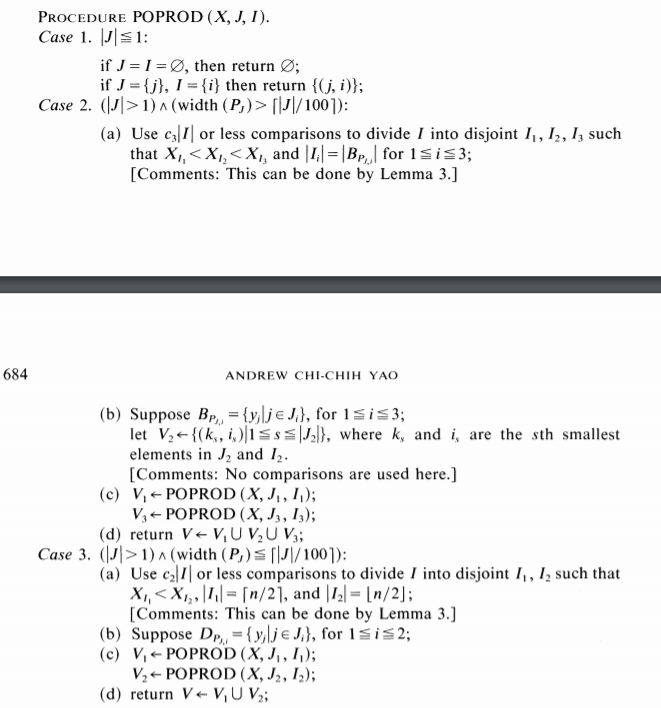Introduction
无论是中位数查找问题,k分位数查找问题,或是排序问题,它们都是偏序产生问题的特例。这里不在赘述偏序的定义,我们让\(P=(<_P,Y)\)是\(Y=\{y_1,y_2,...,y_n\}\)上的一个偏序。从一个给定的输入集合\(X=\{x_1,x_2,...,x_n\}\)中产生P是指:找到一个\((1,2,...,n)\)的自同构\(\delta\),使得\(y_i <_P y_j\)可以推出\(x_{\delta(i)}<_P x_{\delta(j)}\).实际上,从直观上看的话,相当于找到一种把X中的数填到偏序P所对应的n个位置上,当然,要满足偏序的要求。
对任何一个偏序产生算法,我们都可以将其与一颗称为"决策树"的二叉树T对应起来。决策树的每个结点是一个比较\(x_i:x_j\),比较的结果导致了两个分叉,叶节点是算法的输出,它是上一段中描述的自同构。比较次数即从根节点到叶的长度。算法的最坏代价(COST)即最坏比较次数,当然是决策树的最大高度。至于平均比较次数,就是把输入看成等可能的情况所得到的平均比较次数。
如果自同构\(\delta\)将\(\{1,2,...,n\}\)填充到偏序P中,并且满足偏序条件(即\(y_i<_P y_j\)可推出\(y_{\delta(i)}<_P y_{\delta(j)}\)),则称作与P相容。记\(\Delta (P)\)是所有与P相容的自同构组成的集合,记\(\mu (P)=|\Delta (P)|\)。定义C(P)为最坏比较次数,\(\bar{C}(P)\)是平均比较次数。
Schonhage的研究指出\(C(P)\geq log_2 (n!/\mu(P))\),随后Aigner指出,此下界可以渐进地达到,在\(C(P)=O(log_2 (n!/\mu (P)) +n)\)的意义下。在本文中,A.C.Yao证明了
Thm1.\(\bar{C}(P) = \Omega (n-\beta(P)+log_2(n!/\mu(P)))\)
Thm2.\(C(P) = O(n-\beta(P)+log_2 (n!/\mu(P)))\)
从而得出
Thm3.\(C(P) = \Theta(\bar{C}(P))\)
即偏序产生问题的平均意义复杂度和最坏复杂度是同阶的。其中\(\beta(P)\)指偏序P中的连通分支数量,由于偏序实际上可以用一个无圈有向图表示,这里的连通实际上就是有向图的弱连通而已。
Thm1
Thm1来自两个引理
Lem1.\(\bar{C}(P)\geq log_2(n!/\mu(P))\)
Lem2.\(\bar{C}(P) \geq n-\beta (P)\)
Lem1考虑了到达决策树每个叶子\(l\)所产生的偏序\(Q_l\),这些偏序\(Q_l\)当然是包含P的,从而\(\mu(Q)\leq \mu(P)\),并且和\(Q_l\)相容的初始输入会输出到对应的叶子这样的话,并且所有\(\mu(Q_l)/n!\)的和为1(因为任何输入都唯一地决定一个输出),利用信息论的结论就可以给出\(\bar{C}(P)\)的下界。
Lem2直观上十分显然,所以不再赘述证明。
Thm2
Yao先证明了Thm4.\(C(P)\leq \lambda (n-1+log_2 (\frac{n!}{\mu (P)}))\),由它容易得出Thm2.
为了证明Thm4只需要给出一个满足条件的算法就可以了。
准备
称\(A\in Y\)是一个P的独立集,如果对于所有不同的\(y,y'\in A\)都有y不小于y'.P的宽度是P的最大独立集的规模。P的一个k-分割是一个k元子集组\((A_1,A_2,...,A_k)\),各\(A_k\)是对集合P的一个分割,并且\(A_i<_P A_{i+1}\),这里的小于是指任何\(A_i\)的元素小于\(A_{i+1}\)的元素。这里尤其要介绍两类特别的分割。让\(B_p = (B_{p,1},B_{p,2},B_{p,3})\),\(B_{p,2}\)是Y的一个极大独立集\(Y_p\),\(B_{p,1}=\{y| y<_P y' for some y'\in Y_p\}\),\(B_{p,3}=Y-Y_p-B_{p,1}\),这是一个3-分割。记\(M_p\)是所有满足\(|A_1|=\lceil n/2 \rceil,|A_2| =\lfloor n/2 \rfloor\)的2-分割\((A_1,A_2)\)组成的集合。让\(D_p=(D_{p,1},D_{p,2}) \in M_p\)且\(\mu(P_1) \mu(P_2)\)达到最大。接下来,有
Lem3. \(k\in \{2,3\}\),让I是\(\{1,2,...,n\}\)的子集,并且\(n_1,n_2,...,n_k\)满足\(\sum_{1\leq i \leq k}n_i=|I|\),那么存在一个高度为\(c_k |I|\)的决策树T,给定任何n个不同的数\(X=\{x_1,x_2,...,x_n\}\),T决定了互不相交的\(I_1,I_2,...,I_k\)满足(a)\(\cup_i I_i = I\),(b)\(|I_i|=n_i\),(c)\(X_{I_i}<X_{I_2}<\cdots<X_{I_k}\)
其中\(c_2=40,c_3=80\).此引理用了另外文献中的选择算法。
Procedure POPROD
算法的思路是不断递归地将偏序分解为三部分或者两部分(根据上述的“感兴趣”的两种分割,Lem3给出了分割方法),当当前偏序的宽度大于\(n/100\)时,将它分成三部分,小于\(n/100\)时将它分成两部分。如果分成三部分,那么对于中间的独立集\(B_{p,2}\),我们可以将Lem3得出的\(X_2\)与它任意地一一对应(因为\(B_{p,2}\)是独立的),而对于两边的偏序,则递归继续分解,直到偏序集的大小变为1,此时将输入集唯一对应即可。(可以发现,当宽度变为1时,即偏序变为线性序时,算法实际上是一个归并排序)
经过一些繁琐但并不复杂的分析,可以知道POPROD满足Thm4,于是Thm2得到证明。























 8856
8856

 被折叠的 条评论
为什么被折叠?
被折叠的 条评论
为什么被折叠?








